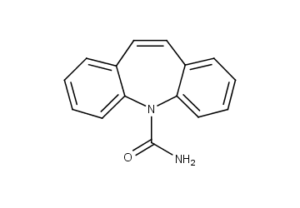Carbamazepine CAS NO 298-46-4 Inquire about Carbamazepine
Tecoland supplies Carbamazepine bulk active pharmaceutical ingredient (API) to the pharmaceutical industry. Our Carbamazepine is manufactured by cGMP compliant facility. Welcome to contact us for further details including current DMF status for the product and up to date regulatory status of the manufacturing facility. We look forward to assisting you with your research and development projects.
What is Carbamazepine?
Carbamazepine (CBZ) (Tegretol, Equetro) is an anticonvulsant and mood-stabilizing drug used primarily in the treatment of epilepsy and bipolar disorder, as well as trigeminal neuralgia. It is also used off-label for a variety of indications, including attention-deficit hyperactivity disorder (ADHD), schizophrenia, phantom limb syndrome, complex regional pain syndrome, paroxysmal extreme pain disorder, neuromyotonia, intermittent explosive disorder, borderline personality disorder, Myotonia congenita and post-traumatic stress disorder.
Like other anticonvulsants, intrauterine exposure is associated with spina bifida and neurodevelopmental problems.
Medical Use of Carbamazepine
Carbamazepine is typically used for the treatment of seizure disorders and neuropathic pain. It may be used as a second line treatment for bipolar disorder and along with antipsychotic agents in schizophrenia.
In the United States, the FDA-approved indications are epilepsy (including partial seizures and tonic-clonic seizures), trigeminal neuralgia, and manic and mixed episodes of bipolar I disorder. Although data are still lacking, Carbamazepine appears to be as effective and safe as lithium for the treatment of bipolar disorder, both in the acute and maintenance phase.
What is the mechanism of action?
The mechanism of action of Carbamazepine and its derivatives is relatively well-understood. Carbamazepine stabilizes the inactivated state of Voltage-gated sodium channels, making fewer of these channels available to subsequently open. This leaves the affected cells less excitable until the drug dissociates. Carbamazepine has also been shown to potentiate GABA receptors made up of alpha1, beta2, gamma2 subunits.
How to dose Carbamazepine?
Usual Adult Dose for Epilepsy
Initial dose: 200 mg orally twice a day (immediate and extended release) or 100 mg orally 4 times a day (suspension).
Increase dose at weekly intervals in 200 mg/day increments using a twice daily regimen of extended release or a three times a day or four times a day regimen of the other formulations.
Usual Adult Dose for Trigeminal Neuralgia
Initial dose: 100 mg orally twice a day (immediate or extended release) or 50 mg orally 4 times a day (suspension).
May increase by up to 200 mg/day using increments of 100 mg every 12 hours (immediate or extended release), or 50 mg four times a day, (suspension), only as needed to achieve freedom from pain. Do not exceed 1200 mg/ day.
What are the side effects of Carbamazepine?
Carbamazepine may cause side effects. Tell your doctor if any of these symptoms are severe or do not go away:
- drowsiness
- dizziness
- unsteadiness
- nausea
- vomiting
- headache
- anxiety
- memory problems
- diarrhea
- constipation
- heartburn
- dry mouth
- back pain
Some side effects can be serious. If you experience any of these symptoms or those listed below, call your doctor immediately:
- confusion
- loss of contact with reality
- chest pain
- yellowing of the skin or eyes
- vision problems
Carbamazepine may cause other side effects. Call your doctor if you have any unusual problems while taking this medication.
Storage
Keep this medication in the container it came in, tightly closed, and out of reach of children. Store it at room temperature, away from excess heat and moisture (not in the bathroom).
Disclaimer:
Information on this page is provided for general information purposes. You should not make a clinical treatment decision based on information contained in this page without consulting other references including the package insert of the drug, textbooks and where relevant, expert opinion. We cannot be held responsible for any errors you make in administering drugs mentioned on this page, nor for use of any erroneous information contained on this page.